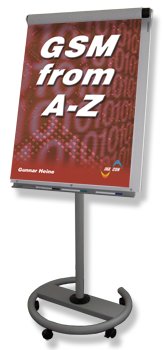 GSM from A-Z
GSM from A-Z
[2-day course, Euro 2,350.- (net) per participant]
 Introduction to GSM
Introduction to GSM

- History and Future of Mobile Communication
- History & Future of GSM
- Comparison – Subscriber Numbers cdma1 <-> GSM
- The GSM Family
- Legacy GSM Network Architecture
- Future Network Architecture (<-> 2006)
- Internal Structure of the IMS
- Tasks and Functions of the IMS
- HLR / AuC (Home Location Register / Authentication Center)
- Tasks and Functions of HLR and AuC
- The MSC / VLR (Mobile Services Switching Center / Visitor Location Register)
- Tasks and Functions of the MSC
- Tasks and Functions of the VLR
- Tasks and Functions of the EIR (Equipment Identity Register)
- The BSC (Base Station Controller)
- Tasks and Functions of the BSC
- The BTS (Base Transceiver Station)
- Tasks and Functions of the BTS
- The TRAU (Transcoding Rate and Adaptation Unit)
- Tasks and Functions of the TRAU
- The Mobile Station
- The Subscriber Identity Module (SIM)
- The Cellular Network
- Location Areas and Cells
- Identifiers of Cells and Location Areas
- Identifiers of the Mobile Station
- Meaning of the IMEI
- GSM Services
- The GSM Protocol Stack
 The GSM Air-Interface
The GSM Air-Interface
- TDMA vs. FDMA
- TDMA and FDMA in GSM
- Resolution of the Propagation Delay Problem
- The ARFCN (Absolute Radio Frequency Channel Number)
- The BCCH-Carrier (Broadcast Control Channel)
- The Frame Hierarchy – Introduction
- The Frame Hierarchy – Reasons
- Logical Channel Types
- The FCCH (Frequency Correction Channel)
- The SCH (Synchronization Channel)
- Other Control Channels
- Configuration of the 51-Multiframe (Example / Downlink)
- Configuration of the 26-Multiframe (DL and UL)
- The Physical Channel in GSM
- The Different GSM-Bursts
- The Different GSM-Bursts
- The GSM-Normal Burst – Power-vs-Time View
- The Frequency Correction Burst
- The Synchronization Burst
- The Access Burst
- The Dummy Burst
- The Normal Burst
- The FACCH, Stealing Resources from its Master Channel
 The Signal Processing Chain in GSM
The Signal Processing Chain in GSM
- The Signal Processing Chain – Transmit Side
- The Signal Processing Chain – Receive Side
- Modulation in GSM
- The In-Phase – Quadrature (I/Q) Presentation
- Consideration of MSK
- From MSK to GMSK
- Phase Changes and Amplitude Variation in GMSK
- Characteristics of the Radio Channel
- Rayleigh-Fading
- Rice-Fading
- Inter-Symbol-Interference
- The Receiver
- The Equalization Process
- Example Equalizer
- Demodulation
- Channel Coding – Overview
- Principles of Convolutional Coders
- Example Convolutional Coder
- The Related Trellis Diagram
- Channel Coding for Enhanced Full Rate Speech
- Interleaving of Speech Traffic Channels
- Channel Coding of the Random Access Channel
- Channel Coding of Other Control Channels
- Block Interleaving of Control Channels (Example: SACCH)
- Slow Frequency Hopping - Reasons
- Slow Frequency Hopping - Procedure
- Options for Slow Frequency Hopping
- Authentication and Ciphering Key Generation
- Ciphering in GSM
- Deciphering in GSM
 Higher Layer Functions
Higher Layer Functions
- PLMN-Selection
- The Cell Selection / Cell Reselection Criterion
- Cell Reselection
- Summary
- System Information Broadcast
- Summary
- Location Updating
- The Mobile Originating Call Setup
- The Mobile Terminating Call Setup
- Measurement Reporting
- Handover
- Intra-Cell Handover
- Intra-BSC Handover
- Intra-MSC Handover
- Inter-MSC Handover
- References
ℹ️ Try out the updated search below!
Search:
More Info:
General Information about this course
Schedule of this training course
Extract of this training course
Buy this book
INACON eBooks
Please have a look at our full offer

